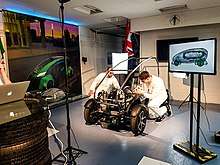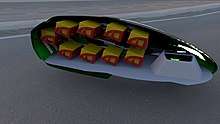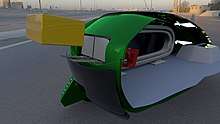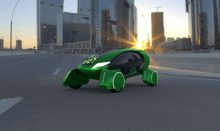kar-go
 | |
| Founded | 2016 |
|---|---|
| Founder | William Sachiti |
| Headquarters | Wales, United Kingdom |
| Owner | Academy of Robotics |
Number of employees | 10+ |
| Website |
academyofrobotics |



Kar-go is an autonomous delivery vehicle, designed and built by the Academy of Robotics,[1] a UK company registered in Wales. The vehicle uses self-drive/driverless car technology to drive itself to locations where it will deliver packages autonomously.[2]
History
The parent company was founded in 2015 by entrepreneur William Sachiti at Aberystywth University.[3] The company was seeded with a £10 000 grant from the University as part of its InvEnterPrize scheme.[3] In late 2016, the company partnered with Pilgrim Motorsport, a specialist UK car manufacturer.[4] In early 2017, the parent company Academy of Robotics was announced to be part of NVIDIA's accelerator to further develop Kar-go.[5] In mid-2017, the company sought funding via Crowdfunding on the UK Financial Services Authority regulated firm Crowdcube. Kar-go raised 320K at a £2million post money valuation. The company has reportedly also raised an additional 300K from an unnamed tech giant at a £2.5m valuation.[6][7][8]
Technology
Kar-go uses Bayesian Simultaneous localisation and mapping (SLAM) algorithms, which fuse data from multiple sensors and an off-line map into current location estimates and map updates. Detection and tracking of other moving objects (DATMO) technology will lower the risk of it crashing into other cars and pedestrians. Sensors include lidar and stereo vision, GPS and IMU. The vehicle also uses visual object recognition and machine vision including neural networks. Inside the vehicle is a series of motors and a package-swapping mechanism which allows the vehicle to deliver packages to recipients.[9][10][11][12]
Production
Kar-go is being built at bespoke car maker Pilgrim Motorsport's UK factory where it is being built from scratch. Chips from NVIDIA will be used, as will battery technology from Renault.[13] Kar-go's team of scientists and engineers are also based at Pilgrim motorsports. The vehicles first street legal prototypes are expected to be on the road for trials in early 2018.[14][15]
See also
References
- ↑ Murray-Nag, Beatrice (25 June 2017). "The kar-go self-driving robot delivers straight to your door". Design Boom.
- ↑ "New driverless Kar-Go delivery vehicle could cut transport costs by 90%". Autocar. 25 June 2017.
- 1 2 "Car-go delivers £10,000 InvEnterPrize". Aberystwyth University. 30 March 2017.
- ↑ "Cambridge should be the perfect test bed for driver-less cars". Cambridge News. 30 May 2017. Archived from the original on 16 July 2017.
- ↑ "NVIDIA : Academy of Robotics is developing Kar-Go – one of the world's first AI controlled pod-shaped driverless vehicles to autonomously deliver multiple packages to residential areas, with the aim to remove the need for humans in last mile delivery". 4-traders. 30 May 2017.
- ↑ "Academy of Robotics Surpasses £300,000 Funding Target on Crowdcube For AI Package Delivery Vehicle "Kar-Go"". Crowdfunding Insider. 10 July 2017.
- ↑ "DRIVERLESS VEHICLE DEVELOPER LAUNCHES CROWDCUBE CAMPAIGN". 30 May 2017.
- ↑ "Academy of Robotics Surpasses £300,000". Crowdcube. 10 July 2017.
- ↑ "Academy of Robotics to unveil driverless delivery vehicle". HonestJohn Vans. 10 July 2017.
- ↑ "Automotive Development SDK | NVIDIA". NVIDIA. 30 May 2017.
- ↑ "Kar-Go autonomously delivers packages to your door". RoboticsResearch. 10 July 2017.
- ↑ "Kar-go the robotic pod can deliver goods direct to your door". CEUTNEWS. 30 May 2017.
- ↑ "Introducing Kar-go: The self-driving robotic pod being tested on British roads that could automatically deliver packages direct to your front door". MailOnline. 30 May 2017.
- ↑ "This Zimbabwean has built a self-driving car in the UK. And it will be on the streets in 6 months". TechZim. 10 July 2017.
- ↑ "Kargo Şirketleriyle Yaşanan Problemleri Ortadan Kaldıracak Çözüm: Otonom Kargo Robotu". Technonews. 30 May 2017.